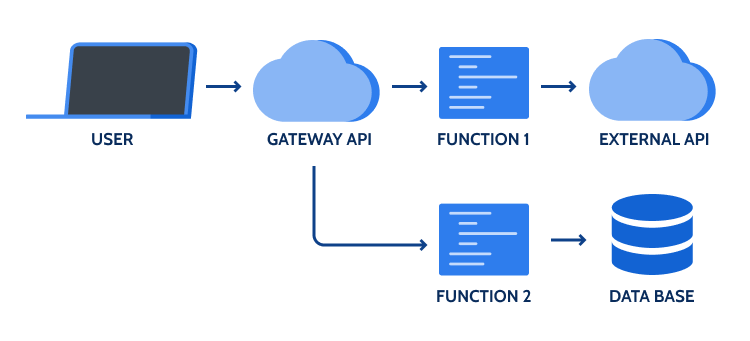Serverless Computing: Under the Hood
Serverless computing has become a transformative force in cloud computing, offering a more abstracted platform for building applications…

Serverless computing has become a transformative force in cloud computing, offering a more abstracted platform for building applications and services. But what actually happens when you invoke a serverless function? How does it work under the hood? Let’s dive into the nitty-gritty details of serverless computing.
Overview of Serverless Computing
At a high level, serverless computing — also known as Function-as-a-Service (FaaS) — allows developers to build and run applications without worrying about the underlying servers. The cloud provider manages the server infrastructure, and developers merely deploy their code, which runs in response to specific events.
Under the Hood of Serverless Computing
Let’s get into the technical details of how serverless works under the hood. While specifics may vary between providers, the following fundamental principles apply broadly:
1. Event Triggers
Serverless functions are event-driven. They are designed to respond to various events such as database data changes, requests to an API endpoint, files uploaded to a storage bucket, or in-app activity.
These events trigger the serverless functions, which are pieces of code written in a language supported by the serverless platform, such as JavaScript, Python, or C#. The code then executes, processes the event, and returns a response.
2. Function Execution
When an event triggers a function, the cloud provider’s serverless platform must find an execution environment where the function’s code can run. This environment includes the selected runtime (the language interpreter), any dependencies, and the function’s code.
If the platform already has an idle environment matching the function’s requirements, it reuses that environment, which results in quicker execution time. If not, the platform spins up a new environment, which involves loading the runtime, dependencies, and function code — a process known as a “cold start.”
3. Stateless Functionality
One key aspect of serverless functions is that they are stateless. They do not store data from one invocation to the next. Each time a function runs, it does so in a fresh environment without knowledge of previous runs. This statelessness allows for easy scaling because new function instances can be created without worrying about shared state or session data.
However, serverless platforms often maintain the execution environment for a certain period after a function finishes running, anticipating another function invocation. If another invocation occurs within this idle time, the platform can reuse the environment, skipping the initialization step and thus reducing latency.
4. Auto-Scaling and Load Balancing
Serverless platforms handle scaling automatically, creating as many function instances as needed to respond to incoming events. This auto-scaling happens in real-time, responding to the volume of incoming events.
Similarly, load balancing — distributing incoming events across function instances — is handled automatically by the platform. This automated scaling and load balancing abstract away significant operational challenges, allowing developers to focus on coding.
5. Infrastructure Abstraction
Under the hood, the serverless platform is doing a lot of work to abstract the infrastructure from the developer. This includes managing physical servers, setting up and maintaining the operating system and language runtime, managing network resources, securing and isolating function execution environments, and much more.
6. Security and Isolation
Serverless architectures inherently promote better security practices as they limit the scope of permissions to the minimum set required for each function to execute its task. Every function execution environment is isolated, meaning that even if a malicious actor managed to inject code into one function, it would not have access to other functions or the broader system.
However, serverless doesn’t mean that developers can ignore security. They need to ensure secure application design, properly manage function permissions and guard against attacks at the application level. Additionally, serverless providers handle many aspects of security at the infrastructure level, such as operating system and network security.
7. Monitoring and Debugging
Due to its distributed nature, monitoring and debugging are more challenging in a serverless architecture. However, many serverless platforms provide integrated monitoring tools to track function execution, performance metrics, and logging information.
With these tools, developers can trace the execution of a function to debug issues or optimize performance. They can also set up alarms and notifications on function metrics like error rates or execution times. However, effective monitoring and debugging in a serverless architecture often require a shift in approach compared to traditional server-based applications.
The Future of Serverless Computing
The future looks bright for serverless computing, with ongoing improvements in cold start times, more available runtime languages, better local testing tools, and advanced observability capabilities. Serverless will continue to push the envelope on abstracting infrastructure management and allow developers to focus more on delivering business value.
Moreover, as organizations increasingly adopt microservices and event-driven architectures, serverless fits neatly into these paradigms, offering an efficient and effective way to build and deploy such applications.
At the same time, serverless technology providers are continuing to innovate. We’re seeing the development of more advanced features for orchestrating serverless functions, real-time streaming applications, machine learning, and more.
In conclusion, serverless computing represents a significant shift in developing, deploying, and managing applications. By understanding how serverless works under the hood, developers can take full advantage of its benefits and mitigate potential challenges. Serverless may not be the right solution for every use case, but when it fits, it offers substantial benefits in terms of scalability, operational efficiency, and cost savings.
Stay tuned, and happy coding!
Visit my Blog for more articles, news, and software engineering stuff!
Follow me on Medium, LinkedIn, and Twitter.
Check out my most recent book — Application Security: A Quick Reference to the Building Blocks of Secure Software.
All the best,
Luis Soares
CTO | Head of Engineering | Blockchain Engineer | Solidity | Rust | Smart Contracts | Web3 | Cyber Security
#cloud #serverless #microservices #stateless #scaling #function #service #computing #infrastructure #event #driven #architecture #deployment #scalable



